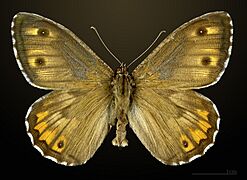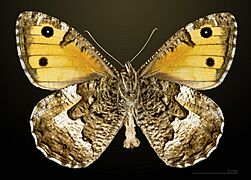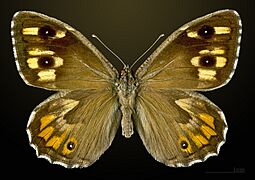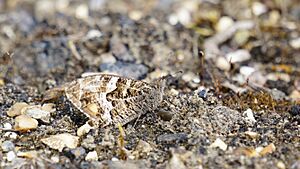Grayling (butterfly) facts for kids
Quick facts for kids Grayling |
|
|---|---|
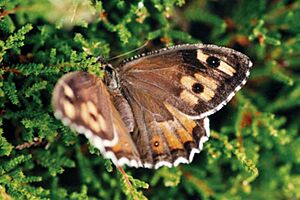 |
|
| Female | |
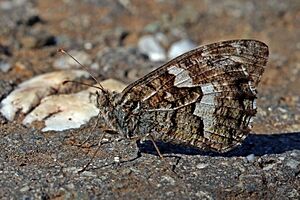 |
|
| male, Portugal | |
| Conservation status | |
| Scientific classification |
The grayling or rock grayling (Hipparchia semele) is a type of butterfly in the brush-footed butterfly family, Nymphalidae. You can find graylings all over Europe. They mostly live near coasts, but their numbers inland have dropped a lot recently. These butterflies like dry, warm places with plenty of sunshine. The sun helps them control their body temperature.
A grayling butterfly goes through four main stages in its life. Eggs hatch around August. The tiny caterpillars (larvae) grow in four stages, from August until the next June. By June, the caterpillars turn into pupae. They spin a silk cocoon underground. The adult grayling butterfly then comes out around August. Graylings often travel in small groups of two or three butterflies during August, usually flying towards the southeast.
Graylings use special cryptic coloring to hide. Their tan and brown wings help them blend in with their surroundings. If a grayling thinks a predator has spotted it, it will show off the "eyespots" on its wings. But usually, they keep these spots hidden to stay unseen. Male graylings are very protective of their space. They perform special flights to decide which male gets the best spot for females to lay eggs. Graylings also control their body temperature by changing how they sit to catch or avoid the sun's heat.
Sadly, grayling numbers have been going down. While they are not endangered globally, they are now a priority for conservation in the United Kingdom.
Contents
Where Graylings Live
The Hipparchia semele butterfly lives from sea level up to about 2,000 meters high. This butterfly species is native to Europe. You can find them almost everywhere in Europe and in parts of western Russia. In northern and western Europe, like Scandinavia, Britain, Ireland, and the Baltic states, they are mostly seen along the coasts. Their populations are shrinking in many areas, especially away from the coast. You won't find graylings in western France, large parts of Greece, Albania, North Macedonia, or south of Bulgaria and the Mediterranean islands.
Grayling Homes
Grayling butterflies usually live in dry places with warm weather. This helps them control their body temperature. You often find them in sand dunes, salt marshes, and on cliffs near the coast. Inland, they live in heathlands, rocky areas, and even old quarries, railway lines, and industrial sites. Grayling groups often settle in areas with little plant growth and open, bare ground. These spots also need places for shelter and sun to help the butterflies warm up or cool down.
What Graylings Eat
Adult Butterfly Diet
Adult Hipparchia semele butterflies are picky eaters. They tend to feed on nectar from specific plants:
- Bird's-foot Trefoil (Lotus corniculatus)
- Bramble (Rubus fruticosus)
- Carline thistle (Carlina vulgaris)
- Heather (Calluna vulgaris)
- Marjoram (Origanum vulgare)
- Red Clover (Trifolium pretense)
- Teasel (Dipsacus fullonum)
- Thistles (Cirsium spp. and Carduus spp.)
Laying Eggs
Hipparchia semele butterflies sometimes lay their eggs on the green leaves that their caterpillars will later eat. Adult butterflies lay their eggs on the ground. This makes it easy for the tiny caterpillars to find their food plants. So, laying eggs directly on the plants isn't always needed for the caterpillars to survive.
Life Cycle
Please note: This information mainly applies to graylings in Great Britain. Details might be a bit different in other places.
Graylings have one generation each year. The female butterfly lays her eggs one by one from July to September. Often, she lays them on the plants the caterpillars will eat. Grayling eggs are white at first, but they turn pale yellow as they grow. The egg stage usually lasts about two to three weeks.
When the eggs hatch, a tiny caterpillar appears. It grows slowly, eating at night. During cold weather, it usually sleeps (hibernates) deep in a patch of grass. The caterpillars are small and cream-colored. They shed their skin four times as they grow. The youngest caterpillars eat in mid-to-late summer. Then, they hibernate while still small, hidden at the bottom of a clump of grass. They start eating again in the spring. Older caterpillars are active at night. During the day, they hide at the base of grass clumps. These caterpillar stages happen from August to June. By June, the caterpillars are fully grown. At this point, they spend most of their time warming up in the sun on bare ground or rocks. Caterpillars also like muddy puddles and sap from tree trunks. When it's time to change into a pupa, the caterpillar spins a cocoon in the ground.
The caterpillar changes into a pupa inside a silk-lined space underground. The pupa is not attached to anything in its little earth cell. The pupal stage lasts about four weeks. Pupae form from June to August, and the adult butterflies come out in August.
Caterpillar Food Plants
Grayling caterpillars eat different types of grasses:
- Sheep's-fescue (Festuca ovina)
- Red fescue (Festuca rubra)
- Bristle bent (Agrostis curtisii)
- Early hair-grass (Aira praecox)
- Tufted hair-grass (Deschampsia cespitosa)
- Marram (Ammophila arenaria)
- Upright brome (Bromus erectus)
- Slim-stem reed grass (Calamagrostis neglecta)
- Grey hair-grass (Corynephorus canescens)
- Cock's-foot (Dactylis glomerata)
- Couch grass (Elymus repens)
- Agropyron species
- Triticum species
Migration
The Hipparchia semele often travels in small groups of two or three butterflies. They usually fly at about 10-11 kilometers per hour. When graylings migrate, they fly in a straight and steady line. They don't stop or make short, darting flights. Graylings usually migrate towards the southeast during most of August.
Staying Safe: Camouflage and Eyespots
The Hipparchia semele butterfly uses cryptic coloring, which is a type of camouflage. This makes them hard to see when they are resting on bare ground, tree trunks, or rocks. Their tan and brown wings help them hide. When they are resting and not flying, these butterflies usually keep their wings closed. They tuck their front wings behind their back wings. This helps them hide their eyespots and makes them look smaller. This helps them blend in even more.
Also, a grayling's front wing has one large and one small eyespot. When the grayling butterfly thinks a predator might have seen it, it shows these spots. However, there's a balance between hiding and showing these spots. Showing their spots might make them easier for predators to see. So, when resting, the grayling uses its camouflage position, pulling its front wings down to hide the eyespots.
Mating and Reproduction
Finding a Mate
When it's time to mate, male and female H. semele butterflies meet above a single tree in a wide, open area. This could be a tall tree in a heathland or a bare patch of ground in sand dunes. The female lays her eggs on different types of thin-leaved grasses, like fescues, bents, and bromes. She lays them a few centimeters above the ground.
Male Butterfly Behavior
Competing for Territory
Male grayling butterflies protect their territories. Females choose males based on who has the best territory for laying eggs. These males compete by performing special flights. The male who wins gets to stay in the territory. Being able to control their body temperature helps these butterflies fly their best to win the best territory.
Showing Off
Male graylings make short, frequent flights. These flights can be spontaneous or planned. They might be a way for males to show off to females.
Female and Male Interactions
Choosing a Partner
Female graylings choose a male who has a good territory. This is called "resource defense polygyny". By choosing a male with the best place to lay eggs, the female helps her eggs have a better chance of surviving. Also, her offspring might inherit the ability to defend good territories, which attracts more females. This helps the female grayling pass on her genes more successfully.
How Graylings Fly
The grayling is a large and easy-to-spot butterfly when it flies. Its flight is known for strong, looping movements.
How graylings fly is also important when males compete for territory. When defending a territory, each male grayling flies in a spiral. They try to fly higher and behind the other male. Once they get into this position, the two males take turns diving and climbing. In the end, the male who can reach the highest position wins the territory.
Body Temperature Control
Graylings prefer to live in open areas with lots of sun. This is because they can control their body temperature using the sun. If it gets too cold, the grayling leans to expose its side to the sunlight. This allows its wings to soak up heat from the sun. If it gets too warm, the grayling stands up straight on its tiptoes. It points its head towards the sun but keeps most of its body away.
Male graylings often change their body and wing positions to control which parts of their body are in the sun. This helps them keep their body temperature just right. So, when it's colder, the male grayling exposes as much of its body as possible to the sun. This is sometimes called sun-basking. This can raise their body temperature by up to 3 degrees Celsius. On the other hand, when it's hot, the male grayling exposes as little of its body as possible to the sun. This can lower its body temperature by up to 2.5 degrees Celsius. When temperatures are in between, male graylings often slowly change how they sit to spread the heat evenly over their body. You can often see male butterflies doing this when they are protecting their territories. Many times, the territories male graylings defend are specific mating spots. Controlling their body temperature helps male butterflies fly their best. This prepares them for top flight performance if another male enters their territory.
Conservation Efforts in Great Britain
The number of grayling butterflies has dropped a lot in recent years. While they weren't seen as important before, Hipparchia semele is now a priority species for conservation in the United Kingdom.
It is now part of the UK Biodiversity Action Plan (Butterfly Conservation, 2007).
Losing Their Homes
Many of the places where Hipparchia semele used to live, like heathlands, have been turned into farmland. Dry habitats are now covered by trees and other green plants. This reduces the best places for graylings to live.







